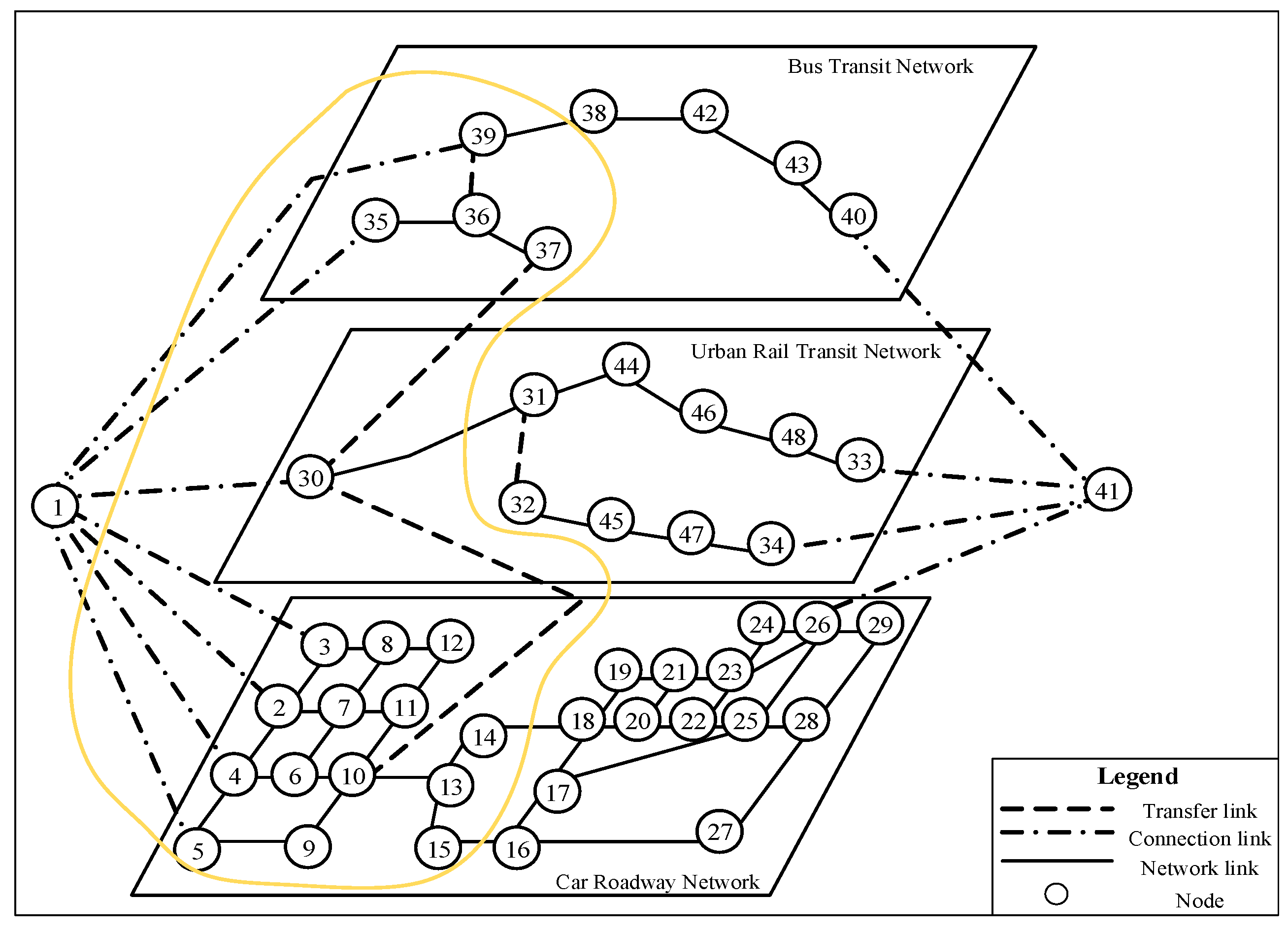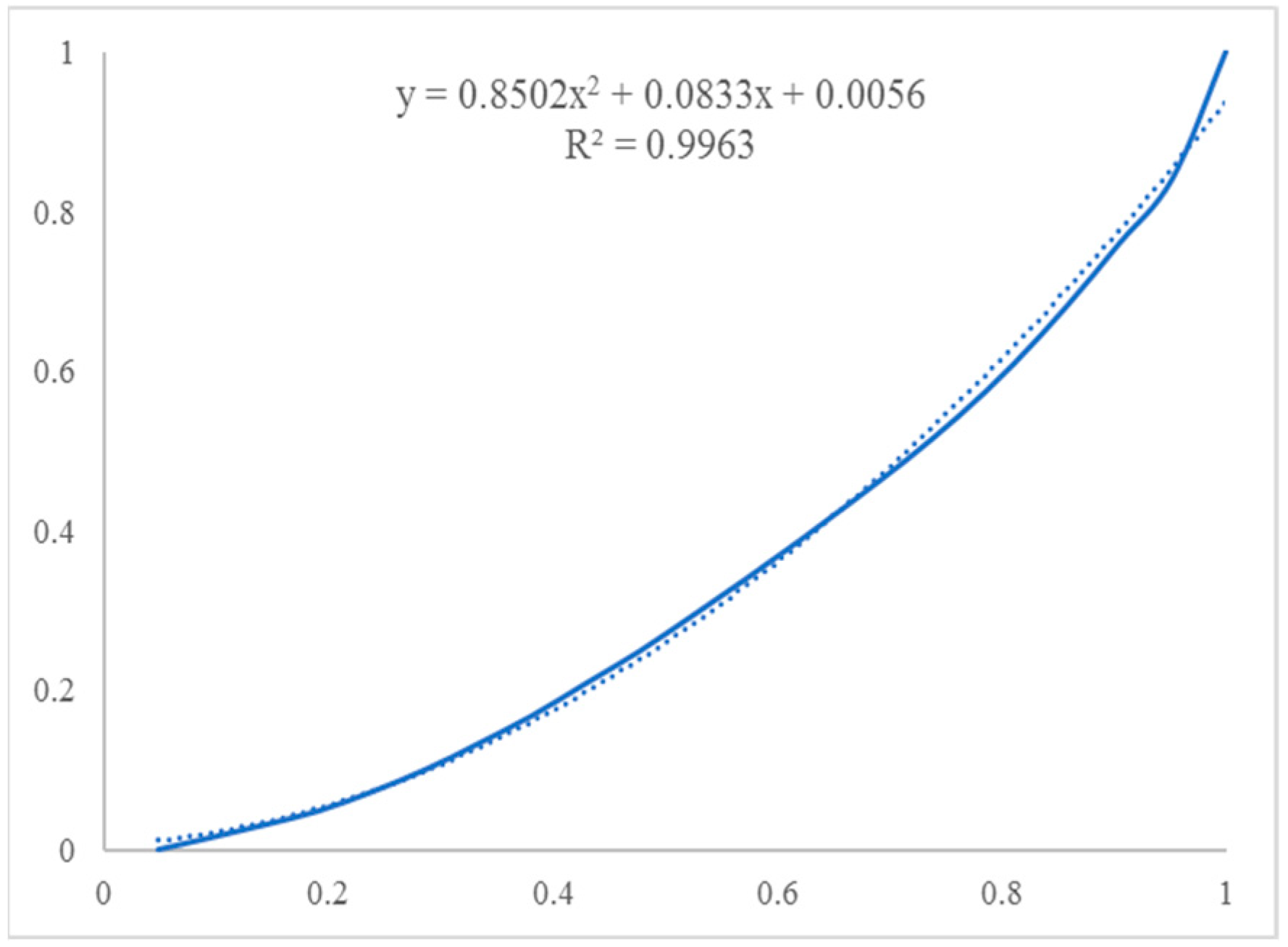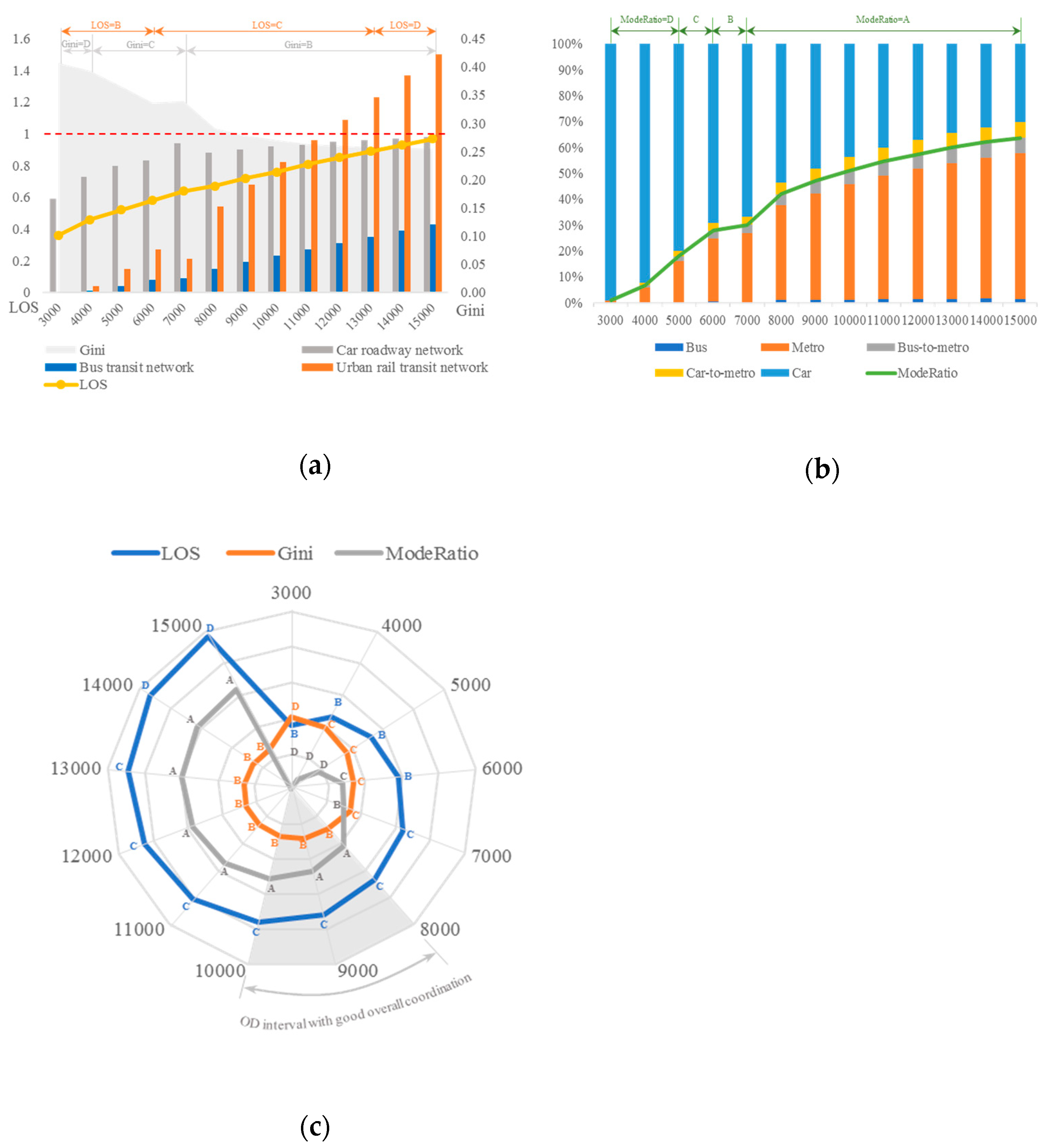Evaluating the Capacity Coordination in the Urban Multimodal Transport Network
Abstract
:1. Introduction
2. Methodology
2.1. Evaluation Process of Capacity Coordination
- Step 1. Obtain the information of urban multimodal transport network (transport facilities, transit operation information, etc.).
- Step 2. Construct the network topology of urban multimodal transport.
- Step 3. Establish the impedance function to calculate the impedance of links and paths.
- Step 4. Quantify the passenger flow of each sub-transport network using SUE assignment model.
- Step 5. Evaluate the capacity coordination via the resulting passenger distribution and the evaluation functions.
2.2. Topology of Urban Multimodal Transport Network
2.3. Impedance Function of Links and Paths
2.4. Model Formulation and Solution Algorithm
- Step 1. Set the number of iterations , and the link flow matrix of the urban multimodal transport network .
- Step 2. Calculate the fares of each link , and obtain path flow and the path fares using Depth First Search (DFS) method. Then, get the shortest path and fares [16].
- Step3. Get the path flow using the Logit model, yielding auxiliary link flow .
- Step4. Calculate new link flow matrix using an MSWA scheme, with .
- Step 5. For an acceptable convergence level , if , stop; otherwise, set , and go to Step 2.
3. Evaluation Functions
- From the perspective of supply–demand balance level of the overall network, it should be possible to evaluate whether the capacity and service level of network under different OD demand scenarios is on a reasonable scale.
- From the perspective of traffic flow assigned in different networks, it should be possible to evaluate the equilibrium of transport network distribution.
- From the perspective of the percentage of public transit travel, it should be possible to evaluate the proportion of passengers that public transit undertakes, since the public transportation can better balance the passenger flow distribution.
3.1. LOS of Multimodal Transport Nerwork
3.2. Gini Coefficient of Multimodal Transport Network
3.3. Mode Share of Transport Modes
4. Numerical Example
5. Results and Discussion
6. Conclusions
Author Contributions
Funding
Institutional Review Board Statement
Informed Consent Statement
Conflicts of Interest
References
- Driscoll, W.; Larsen, P.B. Convention on International Multimodal Transport of Goods. Tul. L. Rev. 1982, 57, 193. [Google Scholar]
- Lin, J.; Ban, Y. Complex Network Topology of Transportation Systems. Transp. Rev. 2013, 33, 658–685. [Google Scholar] [CrossRef]
- Bevrani, B.; Burdett, R.L.; Yarlagadda, P.K. A case study of the Iranian national railway and its absolute capacity expansion using analytical models. Transport 2017, 32, 398–414. [Google Scholar] [CrossRef] [Green Version]
- Ronald, N.; Arentze, T.; Timmermans, H. Modeling social interactions between individuals for joint activity scheduling. Transp. Res. Part B Methodol. 2012, 46, 276–290. [Google Scholar] [CrossRef]
- Burdett, R. Multi-objective models and techniques for analysing the absolute capacity of railway networks. Eur. J. Oper. Res. 2015, 245, 489–505. [Google Scholar] [CrossRef] [Green Version]
- Burdett, R.; Kozan, E. Techniques for absolute capacity determination in railways. Transp. Res. Part B Methodol. 2006, 40, 616–632. [Google Scholar] [CrossRef] [Green Version]
- Minderhoud, M.M.; Botma, H.; Bovy, P.H.L. Assessment of Roadway Capacity Estimation Methods. Transp. Res. Rec. J. Transp. Res. Board 1997, 1572, 59–67. [Google Scholar] [CrossRef] [Green Version]
- Minderhoud, M.; Tavasszy, L.A.A. Strategic Port Choice Model for Worldwide Container Flows. In Proceedings of the Transportation Research Board 88th Meeting, Washington, DC, USA, 11–15 January 2009. [Google Scholar]
- National Research Council (U.S.). HCM2010: Highway Capacity Manual, 5th ed.; Transportation Research Board: Washington, DC, USA, 2010. [Google Scholar]
- Park, M. Capacity Modeling for Multimodal Freight Transportation Networks; University of California: Irvine, CA, USA, 2005. [Google Scholar]
- Mishra, S.; Welch, T.F.; Jha, M.K. Performance indicators for public transit connectivity in multi-modal transportation networks. Transp. Res. Part A Policy Prac. 2012, 46, 1066–1085. [Google Scholar] [CrossRef]
- Friedrich, M. Evaluating the Service Quality in Multi-modal Transport Networks. Transp. Res. Procedia 2016, 15, 100–112. [Google Scholar] [CrossRef] [Green Version]
- Sheffi, Y. Urban Transportation Networks: Equilibrium Analysis with Mathematical Programming Methods; Yosef Sheffi. Prentice-Hall, Inc.: Englewood Cliffs, NJ, USA, 1984. [Google Scholar]
- Asakura, Y. Evaluation of network reliability using stochastic user equilibrium. J. Adv. Transp. 1999, 33, 147–158. [Google Scholar] [CrossRef]
- Liu, H.X.; He, X.; He, B. Method of Successive Weighted Averages (MSWA) and Self-Regulated Averaging Schemes for Solving Stochastic User Equilibrium Problem. Netw. Spat. Econ. 2009, 9, 485–503. [Google Scholar] [CrossRef]
- Floyd, R.W. Algorithm 97: Shortest path. Commun. ACM 1962, 5, 345. [Google Scholar] [CrossRef]
- Thomas, V.; Wang, Y.; Fan, X. Measuring Education Inequality: Gini Coefficients of Education; Policy Research Working Paper Series 1.100; World Bank Group: Washington, DC, USA, 2001; pp. 43–50. [Google Scholar]
- Meng, M.; Shao, C.; Zeng, J.; Dong, C.; Zhuge, C. Traffic assignment model and algorithm with combined modes in a degradable transportation net-work. J. Cent. South Univ. 2014, 45, 643–649. [Google Scholar]






| Evaluation Functions | Indicators | Criteria | Results |
|---|---|---|---|
| LOS of multimodal transport network | LOS ≤ 0.3 | A | |
| 0.3 < LOS ≤ 0.6 | B | ||
| 0.6 < LOS ≤ 0.9 | C | ||
| LOS > 0.9 | D | ||
| Gini coefficient of transport network | GiniLOS < 0.2 | A | |
| 0.2 ≤ GiniLOS < 0.3 | B | ||
| 0.3 ≤ GiniLOS < 0.4 | C | ||
| 0.4 ≤ GiniLOS < 0.5 | D | ||
| GiniLOS ≥ 0.5 | E | ||
| Mode share of transport modes | ModeShare ≥ 40% | A | |
| 30% ≤ ModeShare < 40% | B | ||
| 20% ≤ ModeShare < 30% | C | ||
| ModeShare < 20% | D |
| Network Categories | Attributes | Transport Facilities | Number of Links |
|---|---|---|---|
| Roadway network | Expressway | DAQIAOBEI Road, NEIHUANXI Road, HUJUBEI Road | 40 + 11 (connection links) |
| Arterial road | JIANGSHAN Road, Nanjing Yangtse River Bridge | ||
| Secondary trunk road and branch road | Surrounding Branch roads of HONGWUBEI Road, LIUZHOUDONGLU Railway Station | ||
| Bus transit network | Bus line | Bus Line 532 | 7 (including internal transfer) |
| Bus Line 669 | |||
| Urban rail transit network | Metro line | Metro Line 1 | 9 (including internal transfer) |
| Metro Line 3 | |||
| Transfer virtual network | Bus-to-metro transfer hub | LIUZHOUDONGLU Railway Station | 1 |
| Car-to-metro transfer hub | WEINISISHUICHENG Bus Station | 1 |
| Parameters | Values | Unit | Parameters | Values | Unit |
|---|---|---|---|---|---|
| 1200 (branch road) | pcu/h | 1200 | passengers/hour | ||
| 1350 (arterial road) | 5000 | passengers/hour | |||
| 1500 (expressway) | 3 | min | |||
| 1800 (Nanjing Yangtse River Bridge) | 7 | min | |||
| 3.02 | -- | 10 | min | ||
| 1.19 | -- | 10 | min | ||
| 3.09 | -- | 16 | |||
| 1.4 | -- | 0.1 | -- | ||
| 0.66 | -- | 0.8 | -- | ||
| 0.5 | -- | 0.5 | -- |
| No | Link | Flow | Network | No | Link | Flow | Network |
|---|---|---|---|---|---|---|---|
| 1 | 1-2 | 2568 | Connection network | 19 | 7-8 | 647 | Roadway network |
| 2 | 1-3 | 744 | 20 | 7-11 | 1246 | ||
| 3 | 1-4 | 868 | 21 | 7-8 | 975 | ||
| 4 | 1-5 | 714 | 22 | 8-12 | 1096 | ||
| 5 | 1-35 | 233 | 23 | 9-10 | 788 | ||
| 6 | 1-30 | 1856 | 24 | 10-13 | 4682 | ||
| 7 | 1-39 | 17 | 25 | 10-11 | 2342 | ||
| 8 | 2-3 | 681 | Roadway network | 26 | 11-12 | 1096 | |
| 9 | 2-4 | 1007 | 27 | 13-14 | 2325 | ||
| 10 | 2-7 | 880 | 28 | 13-15 | 2357 | ||
| 11 | 3-8 | 1425 | 29 | 30-31 | 2295 | Urban rail transit network | |
| 12 | 4-5 | 543 | |||||
| 13 | 4-6 | 1802 | 30 | 35-36 | 233 | Bus transit network | |
| 14 | 4-5 | 469 | 31 | 36-37 | 227 | ||
| 15 | 5-9 | 788 | 32 | 36-38 | 6 | ||
| 16 | 6-7 | 940 | 33 | 39-40 | 23 | ||
| 17 | 6-10 | 1764 | 34 | 10-30 | 212 | Transfer virtual network | |
| 18 | 6-7 | 902 | 35 | 30-37 | 227 |
| LOS of Sub-Transport Networks | Passengers of Transport Modes | |
|---|---|---|
| 0.94 (roadway network) 0.09 (bus transit network) 0.21 (urban rail transit network) | 23 (bus) 1856 (metro) 227 (bus-to-metro) | 4682 (car) 212 (car-to-metro) |
| Evaluation Functions | Indicators Calculation | Evaluation Results |
| LOS of multimodal transport network | C | |
| Gini coefficient of transport network | C | |
| Mode share of transport modes | B | |
| OD Demand | LOS | Gini Coefficient | Mode Share (%) | |||
|---|---|---|---|---|---|---|
| 3000 | 0.36 | B | 0.41 | D | 0.96 | D |
| 4000 | 0.46 | B | 0.39 | C | 6.75 | D |
| 5000 | 0.52 | B | 0.37 | C | 17.93 | D |
| 6000 | 0.58 | B | 0.34 | C | 27.86 | C |
| 7000 | 0.64 | C | 0.34 | C | 30.00 | B |
| 8000 | 0.67 | C | 0.29 | B | 42.00 | A |
| 9000 | 0.72 | C | 0.28 | B | 47.00 | A |
| 10,000 | 0.76 | C | 0.27 | B | 51.10 | A |
| 11,000 | 0.81 | C | 0.26 | B | 54.50 | A |
| 12,000 | 0.85 | C | 0.26 | B | 57.40 | A |
| 13,000 | 0.89 | C | 0.26 | B | 59.90 | A |
| 14,000 | 0.93 | D | 0.26 | B | 62.00 | A |
| 15,000 | 0.97 | D | 0.26 | B | 63.71 | A |
Publisher’s Note: MDPI stays neutral with regard to jurisdictional claims in published maps and institutional affiliations. |
© 2021 by the authors. Licensee MDPI, Basel, Switzerland. This article is an open access article distributed under the terms and conditions of the Creative Commons Attribution (CC BY) license (https://creativecommons.org/licenses/by/4.0/).
Share and Cite
Yue, Y.; Wang, W.; Chen, J.; Du, Z. Evaluating the Capacity Coordination in the Urban Multimodal Transport Network. Appl. Sci. 2021, 11, 8109. https://doi.org/10.3390/app11178109
Yue Y, Wang W, Chen J, Du Z. Evaluating the Capacity Coordination in the Urban Multimodal Transport Network. Applied Sciences. 2021; 11(17):8109. https://doi.org/10.3390/app11178109
Chicago/Turabian StyleYue, Yifan, Wei Wang, Jun Chen, and Zexingjian Du. 2021. "Evaluating the Capacity Coordination in the Urban Multimodal Transport Network" Applied Sciences 11, no. 17: 8109. https://doi.org/10.3390/app11178109






